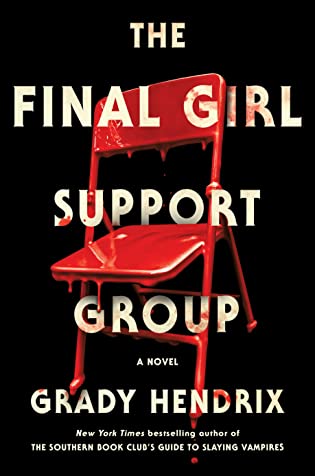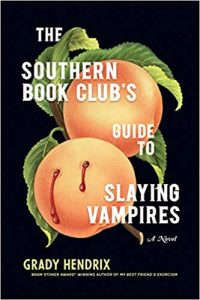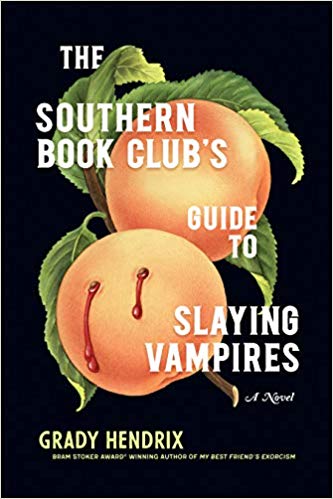 The Final Girl Support Group by Grady Hendrix
The Final Girl Support Group by Grady Hendrix Format: eARC
Source: supplied by publisher via Edelweiss, supplied by publisher via NetGalley
Formats available: hardcover, ebook, audiobook
Genres: horror, thriller
Pages: 352
Published by Berkley Books on July 13, 2021
Purchasing Info: Author's Website, Publisher's Website, Amazon, Barnes & Noble, Kobo, Bookshop.org
Goodreads
A fast-paced, thrilling horror novel that follows a group of heroines to die for, from the brilliant New York Times bestselling author of The Southern Book Club's Guide to Slaying Vampires.
In horror movies, the final girl is the one who's left standing when the credits roll. The one who fought back, defeated the killer, and avenged her friends. The one who emerges bloodied but victorious. But after the sirens fade and the audience moves on, what happens to her?
Lynnette Tarkington is a real-life final girl who survived a massacre twenty-two years ago, and it has defined every day of her life since. And she's not alone. For more than a decade she's been meeting with five other actual final girls and their therapist in a support group for those who survived the unthinkable, putting their lives back together, piece by piece. That is until one of the women misses a meeting and Lynnette's worst fears are realized--someone knows about the group and is determined to take their lives apart again, piece by piece.
But the thing about these final girls is that they have each other now, and no matter how bad the odds, how dark the night, how sharp the knife, they will never, ever give up.
My Review:
Whew! This was an extremely compelling, one-sitting kind of read. I’m not going to say I enjoyed it, because honestly, joy is an emotion that doesn’t get anywhere near this book. But I was certainly fascinated, to the point where I couldn’t stop until I got to the end.
And then I had to go to my happy place for a while to get over the whole experience.
This doesn’t exactly take place in the real world. But it’s close enough to make some really disturbing parallels. Because this is a story that begins with the premise that all of those teenage slasher movies are based on real people’s real stories which have been adapted and exploited for sensationalism and especially for cash..
Which means that the girl – and it’s usually a girl – who survives and kills the monster is a real person who has been violated first by the monster and second by the sexualization of violence against women and third by the system and fourth by all the sick fans and sicker media – is also a real person.
A young woman who has to live her life after all the horrible things that have happened to her with one hell of a case of PTSD. It’s not paranoia if someone really is out to get you, and someone really is out to get all of these women – even before the members of their support group start getting killed, one after another, in VERY rapid succession.
One of those women, one of those survivors, is on the run, desperately trying to keep her shit together and searching for the person who really is out to get all of them. Each twist of the plot is like a turn of the screw for Lynnette Tarkington, as she escapes from custody, alienates all of her friends, and accuses one member of the support group after another as she works her way through her own psychoses along with a breadcrumb trail of clues that is designed to make her look even more crazy than she is. Right before the monster at the heart of this web finally ends her story.
Unless she ends theirs.
 Escape Rating B+: I’m not a horror reader, so I wasn’t expecting to get as involved in this as I did. I also started it with more than a bit of an approach/avoidance conundrum, because not only am I not a horror reader, but I think I was the only person in my reading circle that did not absolutely adore the author’s The Southern Book Club’s Guide to Slaying Vampires last year. I went into this one with concerns that the same issues that tripped me up in that book would appear again.
Escape Rating B+: I’m not a horror reader, so I wasn’t expecting to get as involved in this as I did. I also started it with more than a bit of an approach/avoidance conundrum, because not only am I not a horror reader, but I think I was the only person in my reading circle that did not absolutely adore the author’s The Southern Book Club’s Guide to Slaying Vampires last year. I went into this one with concerns that the same issues that tripped me up in that book would appear again.
That certainly did not happen. This time, the point-of-view character, the not really a Final Girl Lynnette Tarkington really worked for me as a perspective. Her head may have been a really messed up place to be, but it was messed up in a way that felt consistent for her story and her experience. I felt for her even as I was grateful not to be her.
(She kind of reminded me of Linda Hamilton’s character at the beginning of Terminator 2: Judgment Day, all alone and prepping obsessively for a doomsday that she is certain is going to come to pass even if no one else is. And of course her fears are justified, just as Lynnette’s are.)
But the story here mixes its slasher sequel plot of the endless parade of descendants, copycats and slavish fans of the original monster returning to kill the one that got away, over and over again, with a commentary on the sexualization and fetishization of violence against women in a way that is not even subtext, but is actual text underpinning the story. (I certainly saw it as text, but I’m sure people who want to ignore the entire sick, ugly business will either see it as subtle subtext or not see it at all.)
And that’s what disturbed me the most in reading this. While Lynnette comes off as a slightly crazed and increasingly desperate woman, she turns out to be the hero of this story – even though someone is trying to victimize her yet again. That’s what kept me reading through every twist and turn and walk through the valley of the shadow of nightmare. I wanted to see her not just survive, but win – and I was so afraid so often that she wouldn’t.
So I didn’t enjoy this at all, but I felt compelled to keep turning pages and finish. There was absolutely no way this had a happy ending, but I was hoping for catharsis. And I can say that the ending turned out to be relief, release and redemption all rolled into one slightly crazed ball.
I may not have exactly enjoyed this book, but my cats certainly did. I sat still for most of three hours, and they were all overjoyed that I was providing them a warm lap to nap in. I was just glad of their comfort.

 The Southern Book Club's Guide to Slaying Vampires by
The Southern Book Club's Guide to Slaying Vampires by